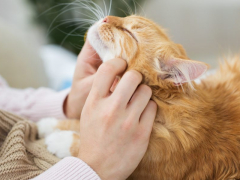
Cats are very curious creatures, which sometimes gets the better of them. Any kind of creepy crawly bug that flies or jumps can be of great interest. Unfortunately, sometimes bees, wasps, and other insects sting (or bite) back. It’s important to recognize an insect bite or sting, know what to do to help your cat, and know when to seek veterinary care.
Causes of Insect Stings in Cats
Insect stings can be very common for cats. If you’ve ever seen your cat chase a fly, you’ve also seen the lengths they might go to try to catch it. Fortunately, your average fly won’t bite or sting, but many other types of bugs can.
The most common stinging insects are:
- Bees
- Wasps
- Hornets
Because the wounds can look very similar, we’ll also cover insect bites. Common biting insects (and arachnids) include:
- Mosquitoes
- Ticks
- Fleas
- Spiders
- Ants
- Flies (namely black flies, horse flies, sand flies, and midges)
Pet parents often ask about house centipedes, which you might find darting for cover in your home or trapped in the sink or tub. They are of common interest to cats but according to the pest control company Orkin, their tiny mouthparts don’t have great capacity for a bite.
Insect bites and stings are more likely to occur outdoors, especially during warmer months, simply because of the large numbers of them. If your cat ventures outside, there’s a greater chance that that they’ll encounter an insect.
But indoor cats are not immune to the risk. Many bugs, including spiders, wasps, and hornets, can gain access to the home through small cracks, windows slightly ajar, holes in screens, or even when you open the door to come in or go out. An indoor cat might be more likely to investigate one of these trespassing bugs.
Insect encounters can be accidental for cats, especially if they wander unawares into a nest or step on a stinging or biting bug. Some bugs, like mosquitoes, fleas, and ticks, actively seek out any warm-blooded animal to feed on, and your cat is no exception.
In many cases, a bite or sting especially from a bee, wasp, hornet, or spider is a result of a cat seeking them out as a prey item.
Symptoms of Insect Stings in Cats
Insect bites and stings can have a great deal of overlap. We’ll also go over some individual variation in insect bites or stings that you might see, but in general, here are some things you’ll see that might help differentiate it from another cause.
- A singular (sometimes multiple) raised red bump(s) or swelling(s)
- Signs of discomfort or irritation at the site(s)
- Signs have occurred in a relatively short period of time
- Signs occurred after a loud vocalization
- Signs occurred after your cat developed sudden frenzied or erratic behavior
- Sometimes a known altercation with an insect or spider has occurred
Here are some variations you might see with certain insects or spiders:
- Bees: Bees might lose their stinger, so you may find it present at the sting site. You might still find multiple bee stings near a beehive.
- Hornets and wasps: These flying insects do not lose their stinger and can sting multiple times, so more than one hornet or wasp sting might be present.
- Mosquitoes: The most common bite locations are areas where cats have less hair, predominantly the nose and ears. Cats usually don’t get a large pale welt like we do but may have a smaller raised red bumps.
- Fleas: Flea bites are often very small and there might be several or more present. More so than the bites, cats with fleas are usually itching and scratching noticeably more than normal. Fleas themselves might be visible but might be hard to find if only a couple are present.
- Ants: Ants are attracted more to food, including leftovers in your cat’s bowl. While any ant can bite, this is uncommon. The exception is with fire ants in the southern United States, which carry a painful venom. Fire ants can be very aggressive and multiple bites are more common. Bites can form small fluid-filled blisters and become very itchy.
- Ticks: Ticks latch on for at least 24 hours to feed when they bite, so they are more often found at the site instead of just the bite itself. After they fall off, they can leave behind a small scabbed area on the skin that might be itchy.
- Flies: Fly bites might be single or multiple and can appear as very small red bumps.
- Spider: Spider bites will usually be single. They are often not immediately irritating, but can form a pustule over a couple of days. The most concerning spider bites are from black widows and brown recluses. Venom from these spiders can lead to more severe wounds over the following days that often require veterinary care.
Also Read: 11 Signs That You Need to Get Your Cat To the Emergency Room
Complications of Insect Stings in Cats

Some cats have allergic reactions from insect bites or stings, and these can be life-threatening.
Two main classifications of complications can be seen from insect stings or bites wounds in cats. The first is an allergic reaction to the bite or sting. This might occur immediately or can develop within a couple hours. The main signs to look for include:
- Severe swelling around the head or neck (even if the bite did not occur there).
- Difficulty breathing. This might appear as panting or increased effort to breathe.
- Hives anywhere on the body. Hives are slightly raised circular bumps that raise the skin and hair. On hairless areas like the belly, they can be red and itchy.
- Vomiting or diarrhea.
- Drooling/excessive salivating.
- Agitation.
- Dizziness and/or disorientation.
- Seizures. These are rare from an insect bite, but can occur with more venomous insects and spiders.
The second classification of complications are delayed immune responses, especially in the skin. Cats can develop skin rashes secondary to insect bites or stings, and sometimes not in the area where the bite or sting occurred. Two common examples include:
Mosquito bite hypersensitivity: Cats very sensitive to mosquito bites can develop an assortment of small red bumps, especially on their ears and the bridge of their nose. These are not the bites themselves, but a skin reaction to them.
Flea allergy dermatitis: Cats with an allergy to flea saliva can develop tiny clusters of red, crusted skin bumps called papules. This is referred to as miliary dermatitis. These are not actually flea bites themselves, but the skin’s reaction to flea saliva.
From a result of scratching an itchy insect bite or sting, cats can also develop rashes and secondary bacterial infections on the skin.
Diagnosis of Insect Stings in Cats
For a cat stung by bees or other insects, your veterinarian might require some background information to combine with their exam of a visible skin swelling. Some insect bites or stings look a lot like other conditions, including skin infections, other allergic skin reactions, and even some skin growths or tumors.
Here are some questions your vet might ask:
- How long has/have the bump(s)/swelling(s) been present?
- Is the area painful or irritating to your cat at home?
- Was an insect, tick, or spider found near your cat?
- Was your cat actively pursuing/hunting an insect in your home?
- Is your cat currently on a flea/tick/heartworm preventative?
- Is your cat indoor only or do they go outside?
Your vet might advise doing some testing on a bump, swelling, or rash to help rule out other potential causes. This might include:
- Swabbing areas that are red, moist, or irritated and viewing samples under a microscope.
- Using a small needle to collect a sample of a blister, swelling, or lump.
- Lightly scraping the skin to look for skin mite infestation.
In the end, without a known interaction with an insect or other bug, it might be hard to determine if a swelling, bump, or rash on the skin occurred from a bite or sting.
If you do happen to have evidence of an interaction with an insect, spider, tick, etc., always try to bring it with you if you are able to safely collect it.
Treatments for Insect Stings in Cats
Some insect bites or stings might not require much in the way of advanced care. Your vet can provide you with a dose for an antihistamine like diphenhydramine (Benadryl) to give at home and might prescribe an ointment to put on a sting or bite location.
If a cat is itching, scratching, or biting a sting site, your vet might advise an Elizabethan collar (the cone) or other method to keep your cat from reaching the area to cause further harm to it.
An antihistamine might not always be sufficient. Some insect bite or sting responses may require a steroid like prednisolone to be prescribed to help reduce the immune response causing swelling, itching, and discomfort.
Some cats that scratch or bite at an insect bite or sting location can develop secondary bacterial infections from the self-inflicted wounds. Antibiotics and other treatments for the skin might be needed in these cases.
Though fortunately less common, more severe reactions to an insect bite or sting might require the use of injectable medications, intravenous fluids, and hospitalized care. Your veterinarian might advise you to take your cat to an emergency or referral hospital if more intensive care is required.
Cat Care Tips
For initial stings, there is some care you can provide your cat at home if all else appears normal.
Cold compresses: If you are safely able to do so and your cat allows it, you can apply an ice pack, bag of frozen peas, or cooled towel to a bite or sting location for five to 10 minutes to help reduce swelling. Wrap the compress in a paper towel or thin cloth. Always make sure the compress is not too cold on your own skin.
Be careful with lotions/creams/ointments at home: Some lotions or ointments might be toxic to pets, so always make sure to check with your vet first before applying anything yourself at home.
Keep a dose of Benadryl handy: You can always ask your vet for the appropriate dose of Benadryl to use for your cat in the event of an emergency. That way, you have it available if you need it. Always avoid Benadryl-D if you have it at home, as the pseudoephedrine ingredient is toxic to pets.
Reduce self-trauma: If you already have an Elizabethan collar/cone at home that will help protect an area from further self-trauma, use it right away to keep an area from getting worse and developing infection. You can also reduce scratching trauma by trimming your cat’s nails if you’re able, or by applying nail/claw caps.
Avoid wrapping or bandaging: Although an article of loose clothing that can cover a bite or sting might be useful, it’s best to avoid intensively wrapping or bandaging an area, especially a leg or foot. Tight bandages can cause more harm than good.
Contact your vet: If a bite or sting location does not subside in redness, pain, or irritation within a couple hours, or if signs worsen, contact your primary care vet or a local emergency vet for further advice.
How To Prevent Insect Stings in Cats

Cut down on the odds of your cat being stung or bitten by a bug by keeping them inside and using a parasite preventive.
Insect bites and stings are not always preventable. Cats will be cats. They love to chase anything that buzzes, flies, or crawls, and we can’t always keep nature out of our homes. But there are some things you can do to reduce risk as much as possible.
Keep your cat indoors: This is not always possible for every cat. But keeping your cat indoors keeps them in a more controlled environment. From a pest and parasite control standpoint, there will always be more chances for your cat to get bit or stung outside.
Use responsible pest control: Depending on the area, some homes are prone to pest invasions, especially by ants, wasps, and hornets. Fleas, ticks, and mosquitoes can be a big problem even in the smallest yard.
If using products yourself, always carefully look at ingredients and follow safety recommendations. Never use an insect repellent or killer directly on your cat. If hiring a service, always make sure they are aware you have pets.
Be aware of your cat’s activity: Many cat parents can tell when their cat’s attention has been suddenly claimed by something they’re trying to hunt or catch. If you notice this change in behavior where your cat is suddenly attentive or engrossed with something small, always look to intervene if you can do so safely. Even if it’s not an insect, it might still be something you don’t want your cat getting into.
Use preventive medication/repellents: Most preventive medications are intended for killing only fleas, ticks, or heartworms, and intestinal parasites. They can prevent disease transmission but few provide insect repellency. Always look at your product labels to view their indications and limitations.
Also Read: 8 Steps to Bringing an Outdoor Cat Inside
Final Thoughts
As curious creatures that like to hunt and investigate, cats can be prone to insect bites and stings. Most will not be serious and might be tended to at home. But any cat should be monitored closely for any concerns for an allergic response that might warrant an emergency veterinary exam.
You can do your part by keeping your home and yard free of pests as much as possible and keeping a close eye if your cat shows a sudden interest in something buzzing, flying, or crawling.
Frequently Asked Questions
Should I be worried if my cat gets stung?
If you’re certain your cat has been stung, you can apply some of the care tips above, including using a cold compress and providing a dose of Benadryl if you have confirmed the dose with your vet.
Like with us, a sting might initially hurt but subside over a few hours.
Watch your cat carefully for the next eight to 12 hours for any signs of an allergic reaction. Any difficulty breathing, presence of hives, or unusual swelling warrants an immediate emergency veterinary visit.
How can you tell if your cat has been stung?
If your cat suddenly vocalizes and acts erratic, and you find a bug capable of biting or stinging nearby, you might assume your cat has been bitten or stung.
But otherwise, it's not always easy to tell if your cat has been stung. Some stings can occur beneath their fur coat. Many cats might not allow a thorough look, especially if an area is painful.
If you’re not sure, it’s best to have your cat examined by your vet to see if an insect bite or sting is likely, or if another cause might be to blame.
How does a cat react to insect bites?
Some insect bites don’t immediately inflict pain or irritation. This includes many spider bites and tick bites. Some will appear very itchy when bitten, like in the case of flea bites.
If a cat is stung by something painful, like a bee, hornet, or wasp, they will usually jump or quickly dash away, sometimes yelling or screaming as well. They will often try to paw or lick at an affected area that hurts. Many cats may then find somewhere to hide.
What does a bug bite look like on a cat?
Most bug bites will appear as a raised red bump. Some might also form a whitehead or pustule, especially in the case of spider bites.
There are many things that can mimic a bug bite on a cat. Skin infections can sometimes appear as raised red dots, as can allergic reactions. Your vet can help determine the differences by examining your cat.
-
Diaz, S. (2022). "Allergy in Dogs and Cats." The Merck Veterinary Manual. https://www.merckvetmanual.com/ear-disorders/diseases-of-the-pinna/allergy-in-dogs-and-cats
-
Dryden, MW. 2022 "Flea Allergy Dermatitis in Dogs and Cats." The Merck Veterinary Manual. https://www.merckvetmanual.com/integumentary-system/fleas-and-flea-allergy-dermatitis/flea-allergy-dermatitis-in-dogs-and-cats?query=flea%20allergy%20dermatitis
-
Weir, M. and Barnette, C. Spider Bites. VCA Animal Hospitals. https://vcahospitals.com/know-your-pet/spider-bites
-
Williams, K and Buzhardt, L. First Aid for Insect Stings in Cats. VCA Animal Hospitals. https://vcahospitals.com/know-your-pet/first-aid-for-insect-stings-in-cats







